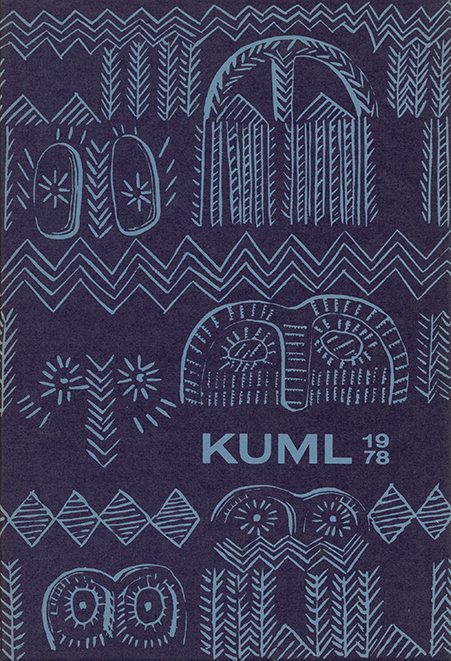Stone Age face pots
DOI:
https://doi.org/10.7146/kuml.v27i27.106890Keywords:
stone age, face-pots, pots with faces, funnel beaker cultureAbstract
Stone Age face-pots
Pots with face-like decoration are known from many countries and occur in Denmark in the Stone, Bronze and Iron Ages, the Stone Age vessels all being assigned to the Funnel Beaker culture. S. Müller and his contemporaries considered them to be limited to Zealand, Funen and Scania; without cultic significance and derived from handled pots. In a number of more recent foreign and Danish surveys, however, the face motif is traced back to west European influence and is accorded religious significance. It is therefore reappraised here.
In the definition, emphasis is placed on the presence of the plastic eyebrows and modelled unperforated nose; some semicircular arcs, mainly on storage vessels, and shouldered vessels with modelled semicircles and circles on the handles are excluded. Two pots in which the motif is engraved are included, however.
A total of 110 unambiguous face-pots are known from the northern group of the Funnel Beaker culture, from 43 finds: 33 passage graves, 3 cairns, 4 indeterminate megalithic graves and 3 with no information on provenance but probably also from megalithic graves. Most of the finds were made in Zealand with the surrounding islands, 2 in Funen and 3 in Mecklenburg. Usually, only a few face-pots are found in each megalithic grave, but the Olstrupgård and Kattrup passage graves yielded respectively 15 and 11 specimens. The face motif occurs in 38 funnel-necked bowls, 14 bowls with concave neck, 8 carinated bowls, 8 bowls with conical neck and 42 vessels of uncertain shape. 42 of the face bowls may be placed in MN IVa, 33 in M II (4 are decorated in insular Danish Ferslev style), and 35 cannot be determined.
The eye motif may be placed on the neck, at the base of the neck, on the belly or at the transition from neck to belly. Two eye motifs consist merely of a semicircle with two eyes underneath; four are formed of two almost circular figures (two made by the same potter) and three are practically anchor-shaped. On nearly all the others the eyebrows form an angle with each other. The eyebrows are either smooth or decorated with short strokes, lunates, circles, rouletting, fir-tree or chevrons. The noses vary from narrow to broad and from short to long. They are either perfectly smooth or decorated with fir-trees or chevrons, vertical rows of various forms of chasing or vertical line groups. In 7 pots the decoration continues from the nose up onto the brow. All seven were found in the northern part of Zealand, and two were made by the same potter. 21 pots lack the eyes; 4 pots, all from north-west Zealand have the eyes on the forehead; 8 pots have ordinary ornament in place of the eyes; while the eyes of the remainder are formed of circles of various kinds. One vessel exhibits eyelashes, a few have marks under the eyes, and 12 pouches.
Outside the Baltic area, Stone Age face-pots are known only from southern and southeastern Europe, the nearest having been found in the south of France (the Peu-Richardt group) and in Iberia, mainly at Los Millares. Both these groups are presumably somewhat older than the Danish and therefore cannot be ascribed to west European influences. The semicircles and circles which are part of the face motif are, however, known as early as MN Ib and II in the Baltic area, just as a group of Hagebrogård bowls and shouldered cups (from MN II and III) with the handle drawn out above into lunates above circles are known from the same area. The pattern on these is highly reminiscent of the face motifs, and it is therefore natural to regard the Funnel Beaker culture's face-pots as having originated as a special Zealand development in MN III -just as the other European groups probably arose as the result of local developments. This evolutionary view of the face motif corresponds exactly to that which has been current in recent years for the megalithic graves.
As all the Scandinavian face vessels have been found in megalithic graves, it would be reasonable to believe that they had a religious function in connection with the grave cult. They were, however, made by the same potters as the rest of the pottery and do not represent any special pot form: they are -apart from the face- decorated with the same patterns as the other pots, and in the bottom of a few, marks of wear have been discerned. The face motif should therefore most probably be regarded as a pattern element like any other, without any particular religious significance.
Klaus Ebbesen
Downloads
Published
How to Cite
Issue
Section
License
Fra og med årgang 2022 er artikler udgivet i Kuml med en licens fra Creative Commons (CC BY-NC-SA 4.0).
Alle tidligere årgange af tidsskriftet er ikke udgivet med en licens fra Creative Commons.


